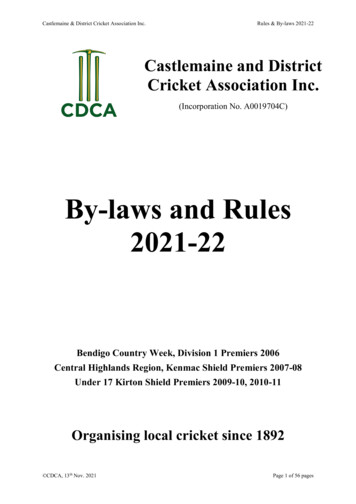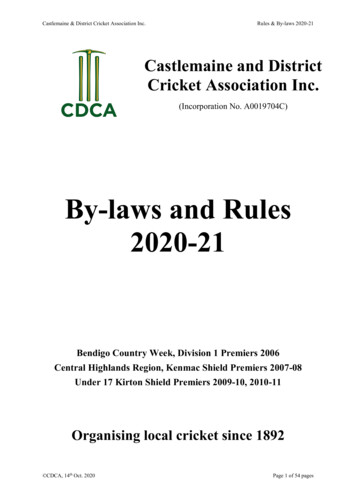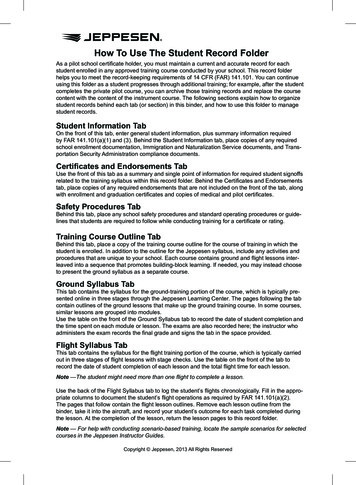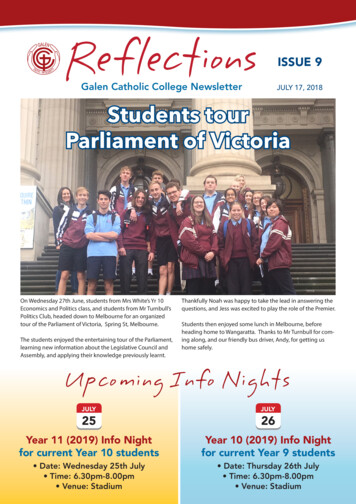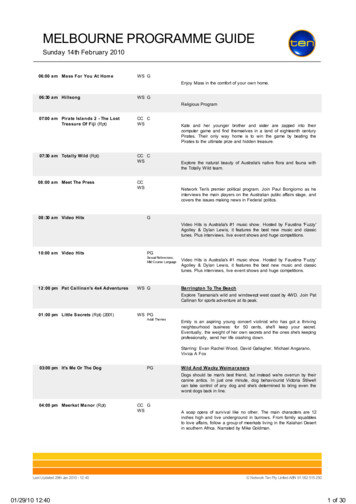
Transcription
Melbourne Cricket GroundCase StudyQFM – The Ideal Solution fora Multi-Discipline Sports andEvents VenueProject:To provide a facility managementsoftware solution for Melbourne CricketGround, the largest sporting stadium inthe southern hemisphere.The Melbourne Cricket Ground (the MCGor known colloquially as the ‘G’), is thelargest cricket stadium in the world. It isalso the largest sporting stadium in theSouthern Hemisphere and the 10th largestin the world. With a capacity of just over100,000 spectators and the tallest lighttowers of any sporting venue, it containsover 2.1 million square feet of buildingsand there are approximately 100 full-timeand 1,000 casual event employeesworking at the Ground. The pitch alonemeasures 171m by 146m.Objectives:To manage up to 100 maintenancerequests on event days and around 20on non-event days; to integrate with arange of other FM and specialistservices; to provide a platform forstreamlined and real-time reporting inorder to enhance service deliveryResults:A seamlessly integrated and efficientsoftware platform for managing workorders in real time; quick, reliable andin-depth reporting; the capacity toexpand to assimilate further technologyand services as they come on streamand be customised as appropriate.1www.swg.cominfo@swg.com
Melbourne Cricket GroundCase StudyOriginally built in 1853, the MCG has beenin a state of almost constant renewalthroughout its history. As well as housingAustralia’s National Sports Museum, theiconic venue has hosted everything froma Summer Olympics, a CommonwealthGames, two Cricket World Cups and avariety of other sporting championships.It has been the home of Australianfootball since 1859, and was thebirthplace of Test cricket in 1877 andone-day international cricket in 1971.Sports journalist Greg Baum describesthe MCG as a shrine. “It is to Melbourne,what the Opera House is to Sydney, theEiffel Tower to Paris and the Statue ofLiberty is to New York; it symbolisesMelbourne to the world. It inspiresreverence.”In order to manage the MCG facility, itneeded to be supported by a softwareapplication with extensive breadth anddepth of functionality as well as thenecessary performance and resiliency, inorder to help maintain its unblemishedreputation.But it’s not just about sport. The MCG hashosted Papal and Royal visits and housedUS Marines, the US Airforce and theRoyal Australian Air Force during theSecond World War. It has also held opendays, charity events and dinners andbeen a concert venue for internationalicons such as Michael Jackson, Madonnaand the Rolling Stones.With a requirement to replace anoutmoded application, the MCGresearched the market for someconsiderable months, before identifyingQFM software from Service Works Globalas the best fit for its needs. QFM wasalready a well-established product inAustralia, having been selected tomanage the facilities for a number ofother high profile projects, including theMelbourne Convention and ExhibitionCentre, the New South Wales ParliamentHouse and the new Royal AdelaideHospital.Located in Yarra Park, Melbourne, andonly ten minutes’ walk from the heart ofthe city, the stadium has a capacity ofmore than 100,000 people, with over 100executive suites. It is open every day ofthe year and visitors can enjoy the manycafes, bars and restaurants there;everything from beer gardens and rooftopterraces to sports bars. It is estimatedsome 3.5m people visit the ‘G’ every year.2www.swg.cominfo@swg.com
Melbourne Cricket GroundCase StudyMeeting the Challenges of aDiverse VenueGreg Wiggill, the Enterprise Applicationsand Technology Support Manager at theMCG explains: “We started working withQFM in 2014 after an 18 monthexploration of the market, trying to findthe best product for our requirements.We wanted something that we didn’tneed to customise and could use straightout of the box to give us the functionalitythat what we needed, yet with theflexibility to adapt to our futurerequirements.”One of the main challenges forMelbourne Cricket Ground was thecontrast in workload between thehundreds of event days held throughoutthe year and non-event days. Duringevent days, between 50 and 100 workrequests can be logged from over 200operatives including MCG staff andexternal contractors, compared toaround 20 requests on a non-event day.QFM manages this by switchingworkflows using a priority setting, whichenables the calls to be managed by thein-house team on non-event days and bya specialist third party service desk onbusy event days.The ultimate goal was a single accurateapplication to proactively handle the fulllifecycle of service calls to reducebreakdowns, service costs, minimise waittimes and optimise service operation andperformance.Having selected and implemented QFM,the MCG began migrating the largevolumes of data from the old system.Data held in the previous MMS(Maintenance Management System)included historic works maintenanceorders and the details of over 8,000assets which are utilised to plan andmanage the Ground’s 10-year assetreplacement strategy, enabling it toaccurately forecast its asset replacementfunding requirements. Migration wascompleted over the course of a weekendand QFM was fully functional and readyto go for the Monday morning.In addition to streamlining work requests,QFM has also improved the rate of firsttime fixes. It manages the resources sojobs can be allocated to operatives withthe required skillset, and by using GPStracking the service desk can see who isgeographically closest in order to reducetravel times. Operatives can access realtime information about the job via theQFM mobile app, allowing the work to becompleted more efficiently and withfewer return visits.The MCG was keen for QFM to be deeplyembedded within the organisation,integrated with its purchase ordersystem, iPOS, and its financial system,Sun Financials. Service Works Globalcompleted the integration work, enablinga complete record of all the costs aroundeach event to be accessible throughQFM. As a result of the integration, datanow only needs to be entered once,reducing duplication and error, savingtime and increasing financial control andtransparency.3www.swg.cominfo@swg.com
Melbourne Cricket GroundCase StudyAt MCG, there is a formal plan to broadenits use of QFM over a period of time. Forexample, the use of QR codes wouldallow easier management of the facility.Codes can be scanned using a mobiledevice, and give operatives access to themain database, showing any maintenancerequired in a particular location.Implementing this functionality wouldoptimise the use of the contractors’ time,underpinned by accurate and readilyavailable data. Following an upgrade toMCG’s Wi-Fi network in 2015, QFM isavailable to the operatives on a superfast, secure high-density system whichhas enabled the practical and expandeduse of QFM’s mobile technology.QFM is also used for recording all lostproperty at the venue. Previously lostproperty records were kept in ahandwritten book, or on a loose piece ofpaper. Visitors who report lost propertynow are recorded on the system, as wellas the items which have been found. Tocope with the sheer volume of items, theitems are categorised as green (onemonth old), orange (two months old) andred (three months or more meaning thatthe items are ready for disposal). Eachmember of the events team receives adaily automated report from QFM toallow the lost property to be efficientlyorganised. After just a few weeks ofimplementing this functionality, 400pieces of lost property were returned to152 owners.As Greg says, “We have the technologyand we want to use it to maximum effectin order to optimise our service deliveryand visitor experience. We have beenimpressed by QFM as a flexible andcustomisable application which has beenable to mould to our environment.”Greg says:One of the reasons this systemhas been so successful at theMCG is that it is so easy to use.The functionality is beingcontinuously developed andbroadened by Service WorksGlobal and we can see even morebenefits of using QFM as timegoes on.“Anyone working in the stadium can useit without much training and it’stransformed us in many areas,particularly with the problem of lostproperty.”4www.swg.cominfo@swg.com
Melbourne Cricket GroundCase StudyIncident ManagementSafety officers are immediately notifiedby the system that an incident hasoccurred so they can attend the scene,and any remedial work needed is notifiedto appropriate staff. QFM’s powerfulreporting is displayed as a user-friendly,visual dashboard which allows the MCGeasy access to information for trendanalysis, thereby reducing the potentialfor future incidents.The more serious issue of incidentmanagement, however, needed more indepth consideration. Service WorksGlobal customised QFM for MCG to meetthe venue’s specific requirements. As aresult, incidents are reported directlythrough QFM, through an intuitivepictorial interface. The incidents are thenlinked to a specific event for easy andeffective reporting. The software handleseverything from recording the incident,cause and type of injury and conditionspertaining at the time, through to witnessstatements. In the event that an assetwas involved in the incident, thisinformation is stored against the asset, sothat follow up action can be taken.Future FocusLooking forward, MCG plans to continue enhancing its use of QFM through BuildingManagement System integration, which will see the venue move away frompreventative maintenance to a predictive maintenance model and more suited to thestop / start nature of the venue. In addition the MCG plans greater leverage of QRcodes and to redevelop how general users enter events into the system.Greg sums up his thoughts about QFM and the impact that it’s had at the venue: “It’sso easy to use. People at MCG are really busy and there’s little time for extensivesoftware training. QFM is incredibly practical for us and the functionality andtechnology that it uses is being enhanced all the time, to ensure that facilitiesmanagement at the ‘G’ moves with the times.”5www.swg.cominfo@swg.com
largest cricket stadium in the world. It is also the largest sporting stadium in the Southern Hemisphere and the 10th largest in the world. With a capacity of just over 100,000 spectators and the tallest light towers of any sporting venue, it contains over 2.1 million square fe
